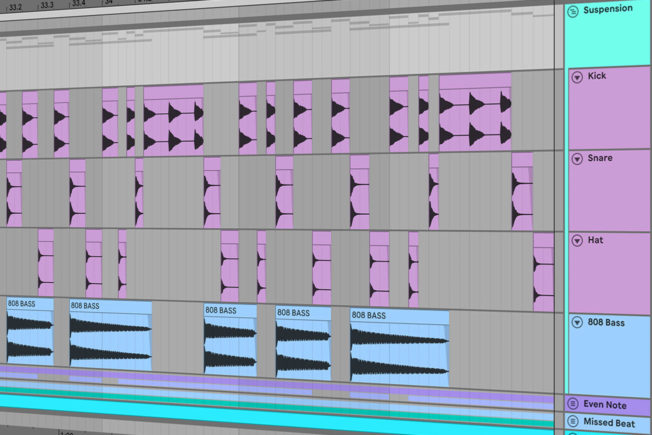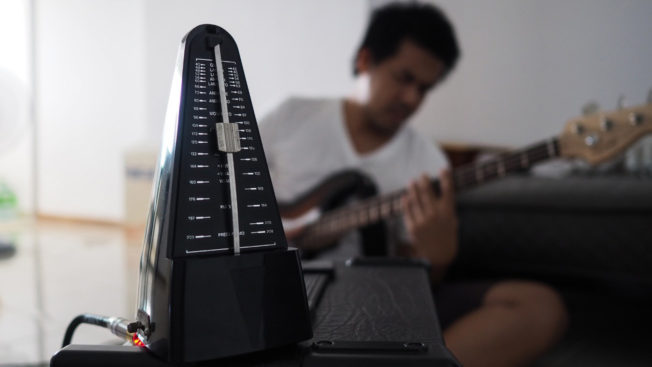Learn about syncopation in music. This basic music theory guide offers tips on how to spice up rhythms to make your music more interesting.

What is Syncopation in Music?
Syncopation in music is the concept of playing rhythms that accent or emphasize the offbeats. It shifts or displaces a standard rhythm by stressing beats generally not stressed.
The time signature of a piece of music identifies a consistent pattern of strong and weak beats. A syncopated rhythm shifts this pattern by emphasizing weak upbeats instead of the strong downbeats.
For example, songs with a 4/4 time signature usually stress the first and third beats. However, a syncopated rhythm may emphasize the second and fourth beats or notes between them.
[yuzo id=”13031″]
Why is Syncopation Important?

Syncopation brings excitement to music by playing with our expectations for where the beat should occur. This groove-inducing tactic breaks away from the strait feel when every note falls on the expected beat.
Syncopation is also attention-grabbing. It surprises the ear by playing on our familiarity and expectations about straight rhythms. Unexpectedly switching the pattern or stressing offbeats adds variation, character, and groove to your music.
Emphasizing notes outside a constant pulse also allows you to create interesting rhythms when recording or performing. It will also give your music a more human quality. Music that plays only on the beat can sound static, boring, and machine-made. It lacks imperfect aspects that make music relatable. By using syncopation, artists make that imperfection sound good.
The Types of Syncopation in Music

The four most common syncopation types are Suspension, Even-Note, Offbeat, and Missed Beat.
1. Suspension Syncopation
Suspension syncopation sustains the weak beats through the strong beats. Instead of playing the strong beats, you hold the weak beats for a longer duration.
For example, you could carry the second beat over the third beat. In the same way, you could sustain the fourth beat of a bar past the first beat of the next bar.
The audio example starts an 808 phrase on the second beat, “suspending” the musical idea. This creates a more dynamic rhythmic feel. It also allows for more creativity while still aligning with the main pulse.
Practice suspension syncopation by considering where a strong beat would make sense. From there, either push it forward to the next beat or pull it back to the previous. Whether that beat is a kick drum, bassline, topline, or anything else, you can apply suspension.
2. Missed Beat Syncopation
Missed beat syncopation replaces a strong beat in a measure with a rest. Like suspension, missed beat emphasizes the weak beats rather than the strong beats. However, there is one primary difference in missed beat syncopation. Silence (known technically as a “rest”) replaces the strong beat instead of the weak note sustaining through the beat.
The kick pattern above omits the last kick of the first bar and first kick of the second bar. By inserting these rests at strategic times, you can emphasize the weak beats more noticeably than with suspension. The technique also works great at building tension or setting up the return to a straight rhythm.
Practice missed beat syncopation by unexpectedly dropping strong notes on beat one or three of a bassline, drum sequence, lead, or other sounds. You will notice how the next beat after the rest feels stronger.
3. Even Note Syncopation
Even note syncopation or backbeat relies on time signatures with an even number of beats, like 2/2, 2/4, and 4/4. By far, the most common time signature in Western music.
Usually, standard rhythms stress odd-numbered beats. With even-note syncopation, you emphasize beats two and four in a standard bar. These are traditionally the weak beats. Whereas one and three are the strong beats.
Below, the chord pattern stresses beats two and four in the first bar. The beat does not technically change. However, the dynamic accents do, creating a different feel.
Beats two and four are also commonly called “backbeats.” By placing emphasis there, you can create different grooves in your music. Overall, the rhythm of a track is in the backbeats. This is why it feels better to clap along to a song on beats two and four. If you clap on one and three, the feeling is robotic and stale. By leaning into the backbeats, you emphasize the rhythm of the music.
Practice backbeat syncopation by stressing even beats like two and four. This approach is the most familiar syncopation type found in drum patterns and chords.
4. Offbeat Syncopation
Offbeat syncopation gets more complex by shifting notes away from the constant pulse. Offbeat occurs when the stressed note falls between beats.
For example, in a 4/4 measure, four quarter notes fill each of the four beats in a bar. With offbeat syncopation, you can introduce beats on eighth notes instead of on quarter notes. This technique separates the music from the pulse of the song by having notes land between the beats.
Moreover, there are two types of offbeat syncopation: beat-level and division-level.
Beat-Level: This syncopation creates a shift across the foundational pulse. The beat remains the same. However, the shift creates emphasis on eighth-note upbeats between two quarter note downbeats.
Division-Level: This syncopation occurs when notes shift to subdivisions of the beat rather than a whole beat. For example, placing beats on a sixteenth note or thirty-second note. The pulse continues on the quarter note. The difference is you’re adding notes outside of that pulse. Stressing beats on a smaller metrical level like this makes the syncopation more complex.
The drum rhythm above starts each bar with a kick on the first beat. But the remaining three kicks in the bar are all offbeat. The second kick plays on the sixteenth note before beat two. While the last two kicks play on the eighth notes between beats three and four.
Playing a note slightly before or after a beat creates an unexpected accent that makes rhymes more interesting. Try it on various elements in your mix.
How to Learn Syncopation and Write Syncopated Rhythms

Here are five ways you can practice syncopation and create syncopated rhythms in your music.
1. Listen to Syncopated Music
Music genres like electronic dance music, reggae, jazz, funk music, and rap use heavy syncopation. Listen to your favorite tracks from these genres and pay attention to how the artists use syncopation.
A trained ear is one of the best ways to learn syncopation and musical form. Try to learn the different time signatures. Then train your ear to identify strong and weak beats for each time signature. This approach will help you make sense of syncopated rhythms.
2. Learn How to Count Syncopation
Start counting syncopated rhythms. Begin by counting the quarter beats. In music, the quarter beats get a whole number. For example, in 4/4 time, count the four quarter notes on each beat as 1, 2, 3, 4.
However, when counting eight-note beats outside the pulse, use “AND” to stress the offbeats. For example, in 4/4 time, count the eighth notes between the quarter beats as 1 AND 2 AND 3 AND 4 AND.
Using a similar technique, you can count sixteenth notes. For example, in 4/4 time, count the sixteenth notes as 1 E-AND-A 2 E-AND-A 3 E-AND-A 4 E-AND-A.
Learning these counting methods will make it easier to understand syncopated rhythms.
3. Practice Syncopation with a Metronome
Metronomes are essential tools that provide a constant pulse to help musicians play in time. The next time you’re producing music or recording vocals, set up the metronome to play at the desired tempo. Then try improvising over the clicks.
You could also use the metronome to practice counting syncopated rhythms. Set aside a few minutes and clap outside of the pulse while the metronome is running. Get a feel for where the weak beats lie and make new rhythms. It will be uncomfortable at first, but the more you practice, the more comfortable you’ll get. This technique will also expand your understanding of rhythms.
4. Break the Standard Formula of Beat Placement
When making music in a DAW, freely placing beats is at your fingertips. Experiment with your beats by changing note velocities and patterns.
Use velocity to stress weak notes. For example, increase the velocity of weak notes and decrease the velocity on strong notes. This technique changes the feel of a groove without changing the note pattern.
Also, try putting notes on parts of the measure where you normally wouldn’t. For example, instead of placing a kick on the first beat, put it on the second or between the first and second. Then listen to how that changes the feel of the music.
Shifting notes to offbeats also works excellent for a percussion section. Practice placing different percussion sounds on subdivisions of the beat. You can drive a straight 4/4 kick pattern while injecting intriguing syncopated rhythms with percussion.
5. Record Rhythms and Convert Them to MIDI in Your DAW
Try recording a few bars of different rhythms by clapping or humming. Then inside the DAW, use the audio file to recreate the pattern with MIDI. If you’re working in Ableton Live, use the conversion commands to convert audio to MIDI. Then you can rearrange notes to tailor your pattern. This technique works great for creating drum patterns, basslines, and leads.
Make sure to run a metronome and clap outside of the pulse. You may not recreate your rhythms identically because of human error when clapping. But by understanding weak beats and off beats, you will get close.
This approach will give you a better understanding of both what syncopated rhythms sound like and look like.
Syncopation Examples Using Popular Music
Syncopation occurs in a variety of music genres. Below are two examples of how syncopation adds interest to a piece of music.
1. Major Lazer – “Lean On”
Major Lazer’s 2015 hit single “Lean On” provides an excellent example of syncopation. Every melodic instance from MØ’s vocals to the topline in the chorus is a syncopated rhythm.
With the kick drum creating the pulse, the melodies would sound bland and stale if they started on the beat. By introducing syncopation, the song sounds more dynamic and interesting.
2. The Police – “Don’t Stand So Close to Me”
The Police have always maintained a strong influence of reggae in their music. Primarily through the drumming of Stewart Copeland. In their 1980 hit song, “Don’t Stand So Close to Me,” Stewart uses reggae rhythms over Brit-pop. Those reggae rhythms are all syncopated.
Another example of syncopation in this track occurs on “drop one,” which, as its name suggests forgoes emphasizing the first beat of the bar. It’s a clear example of missed beat syncopation. By leaving the first beat open, the song adopts a more relaxed feel.
Conclusion
Syncopation injects life into all genres of music by adding variation, character, and groove to otherwise static rhythms. It’s the vehicle that drives exciting music. Without it, rhythms become limited. Keeping rhythms confined to a straight pulse is a surefire way to make your music sound stale and robotic.
By syncopating rhythms, a new world of musical exploration opens up. Syncopation in music also gives you more freedom to express your emotions. You can syncopate drums, basslines, vocals, leads, guitar, and anything else. The creativity is in your hands!